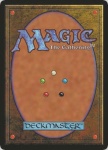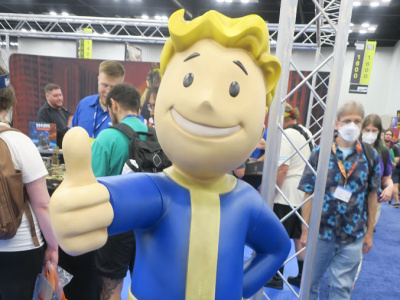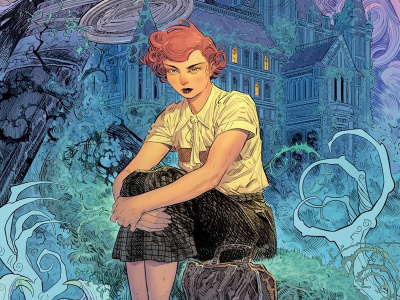 View from the Game Store is a new weekly(-ish) column by Marcus King of Titan Games & Music in Battle Creek, Michigan. This week, King looks at what makes a game successful.
View from the Game Store is a new weekly(-ish) column by Marcus King of Titan Games & Music in Battle Creek, Michigan. This week, King looks at what makes a game successful.Hi, my name is Marcus King, I own two game stores in Michigan (Battle Creek, and Kalamazoo) called "Titan Games & Music." My stores are "entertainment" stores--we sell roleplaying games, board-card-war games, miniatures and video games & systems, as well as DVD movies & sets, music CDs and records, comics (new and back issues) and other entertainment themed merchandise. I have been in the "game industry" as a profession since 1986, when I opened my first store in Anchorage, Alaska. Titan Games has been around since 1994, and has been in its current location in Battle Creek for 9 years. The Kalamazoo store is about to have its first anniversary.
I am going to be writing what we will call a "weeklyish" column for ICv2. In this column I will cover various things from a retail storeowners perspective. I plan to do this about 3 times a month, and may take a week off here and there for things like the Gama Trade Show or Origins, Gen Con or Dragoncon--all of which I used to attend, and some of which I will be attending this year.
This week I wanted to talk about "success" in the game industry. And, more specifically: Defining Success:
Not from a retail store standpoint, mind you, but from a "what makes a game successful" kind of position. I have been in the industry long enough to have friends who are writers and authors (where I would define writer as someone hired to write something, and an author as someone who created something he and maybe others write about), artists, retailers, publishers and distributors. But, when these folks talk about a game being "successful" there is a big communication gap. We may as well be speaking different languages. Lets take a Collectible Card Game as an example.
Having spoken to a lot of writers and artists--it is my impression that they see a game as successful if they, themselves, got paid for their work. Often, it seems to me, I hear that X artist or Y writer didn't get paid, or got paid in product. So, it seems from my perspective, that the creative folks find a product to be successful if they got paid for their part in the creation process. By this standard, maybe 75-90% of CCGs are successful.
The publisher wants to sell the product they have developed and printed--and at least cover expenses and make some profits (hopefully lots of profits). Since they often need to sell about 25% or so of the print run to hit break even (on cost of goods printed)--publishers often may (from what I have read and been told) consider a product to be successful once that threshold has been achieved. And, I would surmise that from this perspective, CCGs are successful for publishers about 50-60% of the time.
Distributors need to sell the product they buy. Being frugal helps. If distributors can sell about 90% of what they bring in, this may be successful for them. I cannot guess as to what the percentages of CCGs distributors are successful with. I would take a wild stab and say about 50% of first release CCGs hit this criteria for distributors. (I am more guessing here, because distributors are more closed-lipped about their dealings, and I have NO first hand experience in distribution).
Retailers buy the product paying the HIGHEST per unit price. If it sells, they make the second largest markup. They also can buy in the lowest quantity, so that does give the retailer some advantages. However, the retailer must sell at least 60% of what they bring in, at full retail, to break even on COGs (cost of goods). And, from my own experience, and what I have been told by fellow retailers--we really only consider a CCG Successful if we sell what we ordered, and have to bring in more--thus creating a buying community for this product, which we can sustain for a length of time. This is partly because our customers are non-static.
See, the consumer that comes to our shop does not open an account with us, they just walk in. Distributors order from publishers, retailers order from distributors--and both of these examples are of a "static customer" relationship. But consumers can shop any-old-where, and therefore are non-static customers.
As a retailer: A game, to me, is successful when it helps me achieve a STATIC relationship with a consumer base--and said base becomes a revenue stream (just like retailers are for distributors, and distributors are for publishers). Thus, in my experience--only about 2 to 3 percent of all CCGs released have ever been successful--for me.
Magic, Pokemon, Yu-Gi-Oh!, Legends of the Five Rings, LOTR, Star Trek, Star Wars, Vampire, Rage and very few others were ever successful for "my stores." I am certain that other shops do very well with many other games. But, here, I am defining MY standard of success for a CCG. And, in fact, in my experience, it might be that only 1% of all CCGs ever released were successful by my criteria.
And, really, nobody can define what success means for someone else.
Next time: I will talk on the relationships between publishers, distributors, retailers and consumers.
The opinions expressed in this column are solely those of the writer, and do not necessarily reflect the views of the editorial staff of ICv2.com.







